Exploring the Statistics Behind Motorcycle Crashes in the United States
Riding a motorcycle can be an incredibly exhilarating experience. Biking allows the rider to enjoy a level of spontaneity and speed that is challenging to match in any other motor vehicle. However, motorcyclists are at significantly higher risk of harm in a crash than other drivers. Without the frame of a car around them to offer protection during a collision, bikers are exposed to incredible impact forces that can cause serious or fatal injuries.
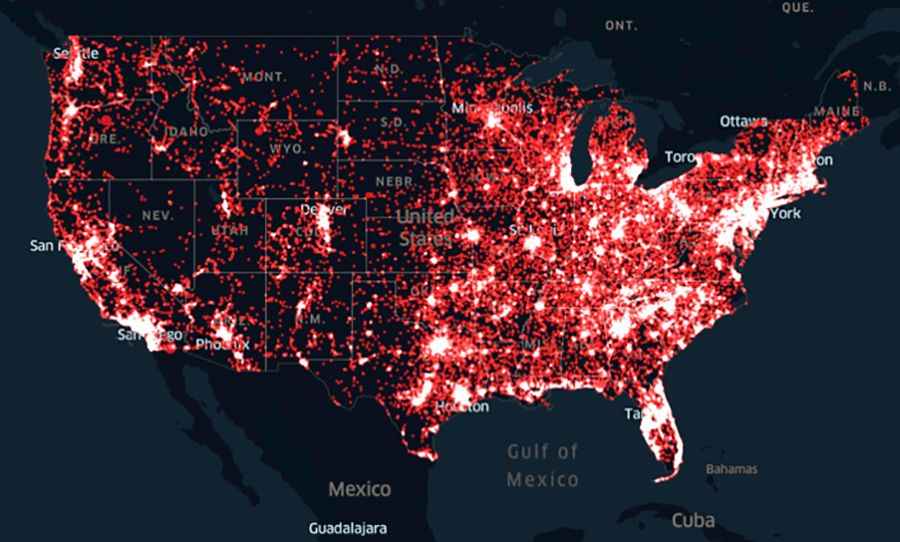
There are more motorcyclists on the roads today than ever before. Statista estimates that there were roughly 8.32 million private, commercial, and publicly owned motorcycles in the United States in 2020, the most recent year for which statistics are available. With motorcycle ownership and usage rising, we wanted to take a closer look at what risks are associated with them. Using data collected by the O’Sullivan Law Firm in Colorado, we’re able to see when, why, and how motorcycle crashes occur across the country.
When Do the Majority of Motorcycle Accidents Occur?
According to figures gathered by the National Highway Traffic Safety Administration (NHTSA), fatal motorcycle accidents are most likely to happen during the daytime, in good weather, and during the summer months. Simply put, crashes are most likely to occur when riders are on the roads in large numbers. An overwhelming 61% of fatal motorcycle crashes between 2000 and 2019 occurred between May and September, as shown below.
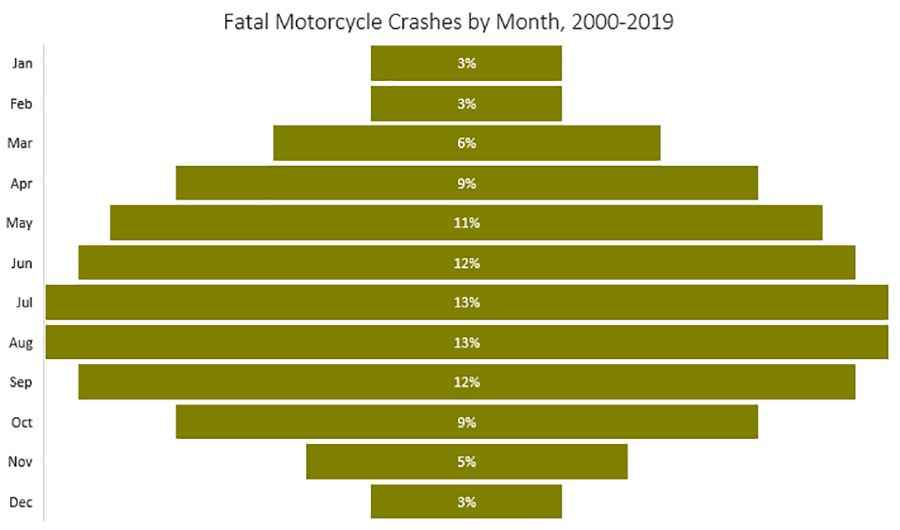
Why Most Fatal Motorcycle Crashes Occur Close to the Rider’s Home
Similarly to other forms of fatal motor vehicle incidents, lethal motorcycle crashes are likely to occur close to the rider’s home. Understanding the Oregon helmet law can help motorcyclists stay compliant with safety regulations and reduce the risk of severe injuries in an accident. Per the NHTSA, over half of fatal motorcycle accidents from 2000-2019 occurred within a 10-mile radius of the deceased rider’s ZIP code (58%). 37% of these crashes occurred within a five-mile radius, and 5% occurred within a 1-mile radius. Accidents are more likely to happen closer to a rider’s home because:
- Urban areas have more traffic and crashes are most likely to occur at an intersection
- Cities have more pedestrians and bikers, who may cause a motorcyclist to swerve, brake abruptly, or drive erratically
- Urban road conditions may be poor, with debris, construction, or potholes contributing to accidents
- Emergency vehicles are more common within city limits, which can lead to additional accidents
What Kind of Motorcycle Crashes Are Most Common?
Most motorcycle crashes involve multiple vehicles, as opposed to single-motorcycle crashes. Fully half of motorcycle crashes over the previous two decades involved at least one other motor vehicle. The second-most common cause of motorcycle crashes was a bike rollover. Collisions with other objects (such as trees, guardrails, or utility poles) were relatively uncommon in comparison. A full breakdown of crash factors is visible in the graph below.
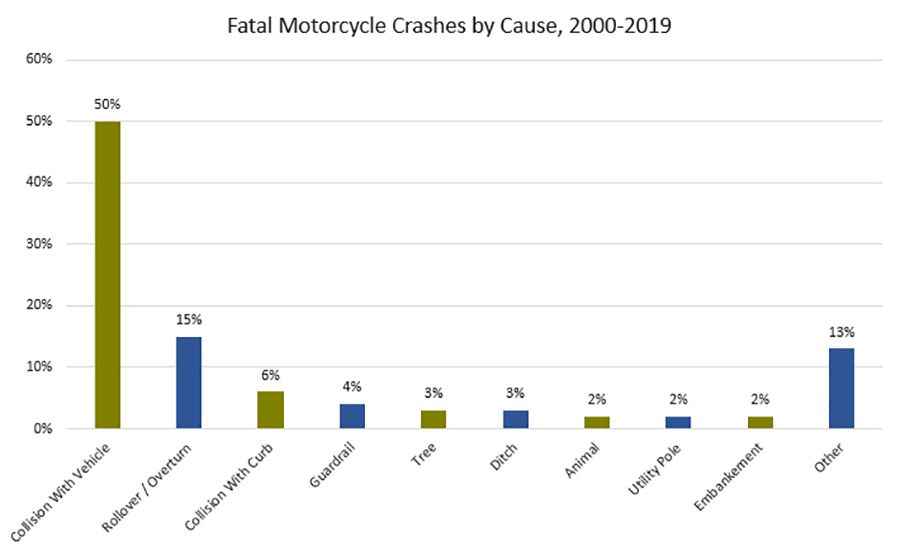
Who is Most Likely to be Involved a Motorcycle Crash?
Juxtaposed with drivers in other types of motor vehicles, motorcyclists involved in deadly collisions are likely to be middle-aged males.
- Nearly all (96%) motorcyclists killed in riding accidents between 2000-2019 were male. Over the same timeframe, 69% of crash victims driving other vehicles were male.
- 87% of motorcyclists killed in crashes were Caucasian.
- The most common age range for motorcyclists killed in accidents was 20-25, but bikers were nonetheless 33% more likely to fall within the age range of 40-60 when compared to other motorists. A breakdown of fatal motorcycle crashes by age is visible below.
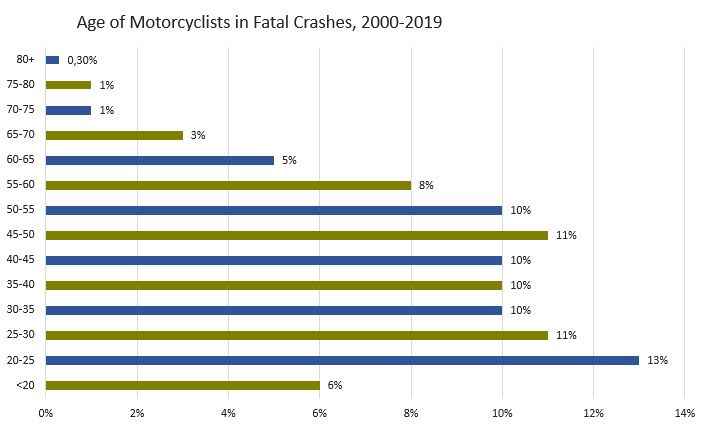
How Effective Are Helmets at Preventing Motorcycle Fatalities?
Department of Transportation (DOT) certified helmets are estimated to be 37% effective in preventing fatalities to motorcycle riders and 41% effective at preventing fatalities to motorcycle passengers. While these numbers may seem disheartening, it’s important to remember that motorcyclists have none of the protection offered by conventional motor vehicles in the event of a crash (airbags, impact-reducing vehicle frames, etc.). Every life saved by a motorcyclist’s decision to wear a helmet is significant.
From 2000-2019, 42% of motorcyclists killed in crashes were not wearing helmets. In 2020, 40% of motorcyclists killed nationally were not wearing a helmet during the fatal collision. Over this timeframe, 39% of motorcyclists surveyed confessed to riding without a helmet.
The Ten U.S. Cities With the Most Fatal Motorcycle Crashes
Of the ten most dangerous cities for motorcyclists, seven are in the state of Florida. In 2020, Florida had the second-most registered motorcycles of all states with 620,077. Only California had more registered motorcycles, at 785,424. Notably, Daytona Beach Bike Week brings an estimated 500,000 people to the area annually for a 10-day motorcycle event – the largest event of its kind in the nation. The city of Daytona Beach consequently has a per-capita rate of crashes nearly double the next city on the list.
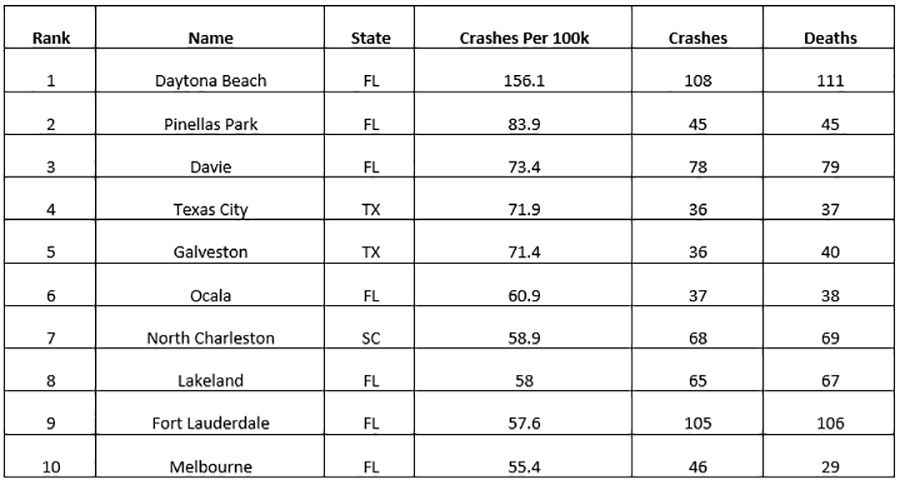
How to Protect Yourself While Riding a Motorcycle
Riding a motorcycle can be exhilarating, but the risks to a rider’s health are considerable. To help motorcyclists stay safe on the road, we compiled this list of safety tips.
- Take a safety course: Motorcycle safety courses help you train for unexpected incidents that can occur during a ride. They also help motorcyclists hone their skills and reaction time.
- Wear motorcycle gear: Wearing a DOT certified helmet, goggles, and protective clothing shields you from debris and road rash. You’ll also be better protected if a collision occurs.
- Inspect your bike before each ride: Checking your motorcycle for any defective or dangerous conditions can keep you safe on the road.
- Be visible to other drivers: It’s easy to accidentally move into a motor vehicle’s blind spot without realizing it. Try to avoid lingering in another vehicle’s blind spots, wear reflective clothing, and clearly signal lane changes.
- Maintain a safe following distance: Tailgating is as dangerous for bikers as it is other drivers. Always leave yourself room to react if the vehicle ahead of you brakes suddenly or begins driving erratically.